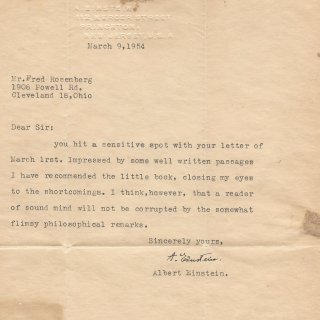Albert Einstein Feels Compelled to Defend a Book For Which He Had Written the Forward, When He Is Quoted Passages Insinuating That Relativity Is Not a Measurable Phenomenon, As Einstein’s Work Maintains


In a previously unknown letter, he justifies the forward, though admitting the book contains "flimsy philosophical remarks”, by saying he had been "impressed by some well written passages”.
He tells his young correspondent, "You hit a sensitive spot with your letter of March 1st."
In 1905, while a young patent clerk and physicist in Bern, Switzerland, Albert Einstein obtained his doctorate and published a paper that explained his newly developed Special Theory of Relativity. This unlocked many mysteries of the...
He tells his young correspondent, "You hit a sensitive spot with your letter of March 1st."
In 1905, while a young patent clerk and physicist in Bern, Switzerland, Albert Einstein obtained his doctorate and published a paper that explained his newly developed Special Theory of Relativity. This unlocked many mysteries of the universe, and introduced the world to "E=mc2," equating mass and the speed of light with energy. It established that time and space are not fixed, and in fact change to maintain a constant speed of light regardless of the relative motions of sources and observers. It showed space as a four dimensional universe, with time added as the fourth dimension. Just 10 years later, in 1915, Einstein published his General Theory of Relativity, in which gravitational effects are explained by the warping of space-time. In this theory, Einstein incorporated gravity as a geometric property of space-time. This expanded upon Special Relativity to describe the overall structure of the universe and the impulses of a gravitational universe. The two theories built on each other and were intimately related.
Such an overall theory was revolutionary and required some re-visiting of centuries-old notions of space and time. What is space? What is time? The great scientists and philosophers back through the ancient Greeks had analyzed this question. It is one of the great philosophical challenges humanity has attempted to tackle. Einstein held that a theory was not valid if it could not be tested in the real world, that his theories were scientifically based and centered around elements that could be measured. This made space and time measurable entities that existed external to our subjective perceptions, a concept that flew in the face of the great German philosopher Immanuel Kant, who had written, “Space is not something objective and real, nor a substance, nor an accident, nor a relation; instead, it is subjective and ideal, and originates from the mind's nature in accord with a stable law as a scheme, as it were, for coordinating everything sensed externally.”
In the 1950s, Lincoln Barnett published the popular and widely read "The Universe and Doctor Einstein”, a book designed to make Einstein's theories accessible to the average person, and one still in print today. Einstein himself wrote the forward to this book. On March 1, 1954, Fred Rosenberg wrote to Einstein summing up the work and criticizing it in detail as contrary to Einstein’s own conclusions, saying: "The author goes on to quote Bishop Berkeley…'Since qualities only exist in the mind, the whole objective universe of matter and energy, atoms and stars, does not exist as a construction of the consciousness, an eclipse of the conventional symbols shaped by the senses of man… So long as they are not actually perceived by me, or do not exist in my mind or of any other created spirit, they must have no existence at all'…. Your theories belong to the centuries… because they reflect something real and objectively true about the nature of the universe; because they rest on empirical evidence; they have have been used to predict real phenomena…Your theories are based on a belief (exactly contrary to Berkeley, Locke and Hume) that… 'man may yet attain a knowledge of physical reality.' Dear Dr. Einstein, I appeal to you, who have done so much for the future of mankind and who has taken such an advanced position on many occasions against retrogression in human affairs, to thwart medievalism in the vital field of philosophy."
Rosenberg’s letter cut to the heart of Einstein's work and legacy. Einstein believed that the theories he was creating were measurable, real, and not subjects of our internal constructs, even if they were measured "relatively.” So Einstein thought it was necessary to respond.
Typed letter signed, on his blind embossed Princeton letterhead, March 9, 1954, to Rosenberg. "Dear Sir – You hit a sensitive spot with your letter of March 1st. Impressed by some well written passages, I have recommended the little book, closing my eyes to the shortcomings. I think, however, that a reader of sound mind will not be corrupted by the somewhat flimsy philosophical remarks.” This letter was acquired from the descendants of the recipient, is unpublished, and has never been offered for sale before.

Frame, Display, Preserve
Each frame is custom constructed, using only proper museum archival materials. This includes:The finest frames, tailored to match the document you have chosen. These can period style, antiqued, gilded, wood, etc. Fabric mats, including silk and satin, as well as museum mat board with hand painted bevels. Attachment of the document to the matting to ensure its protection. This "hinging" is done according to archival standards. Protective "glass," or Tru Vue Optium Acrylic glazing, which is shatter resistant, 99% UV protective, and anti-reflective. You benefit from our decades of experience in designing and creating beautiful, compelling, and protective framed historical documents.
Learn more about our Framing Services








































































































